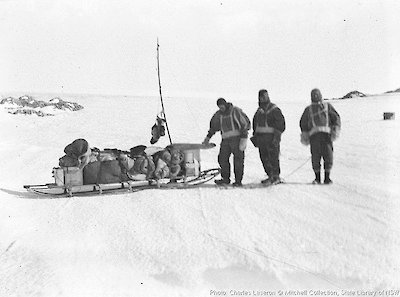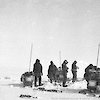The Near East
The East Coast Sledge Journey departed Cape Denison 8 November 1912; farthest point 21 November 1912; returned 27 November 1912; distance travelled c 180 km.
The Near East Coast Survey party departed Cape Denison 9 December 1912; farthest point 29 December 1912; returned 5 January 1912; distance travelled c 180 km.
The two groups that departed on 8 November were both headed east. One of them, under Cecil Madigan, with Archie McLean and Percy Correll would explore the coast beyond the large glacier (later to be named for Xavier Mertz) that Aurora had encountered en route to Cape Denison. The other, comprising Frank Stillwell (leader), Alfred Hodgeman and John Close, would seek to examine in greater detail the coastal lands between Cape Denison and Mertz Glacier.
After a rendezvous with Mawson’s ‘Far Eastern’ party, Stillwell’s and Madigan’s groups headed due east before parting company on 19 November. The ‘Near Eastern’ party under Stillwell reached the summit of an ice dome named after HA Hunt, head of the Australian Bureau of Meteorology, before returning to Cape Denison. After their arrival on 27 November, Laseron replaced Hodgeman before another departure on 9 December to explore the coast around Cape Gray, at the eastern end of Commonwealth Bay.
Their journey came within a hair’s breadth of a premature end during breakfast at Aladdin’s Cave. Drifting snow had blocked the cave’s exit, causing a build-up of carbon monoxide from the cooker. Near to fainting, Close knocked a hole in the exit tunnel to allow the fumes to escape, but all three men were unconscious for over an hour and were too weak to resume travelling for another day.
Much of the Near Eastern party’s remaining time was spent mapping in detail the coast and offshore islets between Commonwealth Bay and Watt Bay to its east. With Charles Laseron in the group, bird observations and collecting also took much time, especially around major nesting sites on the eastern shore of Cape Gray (named after Percival Gray, second officer aboard Aurora).


